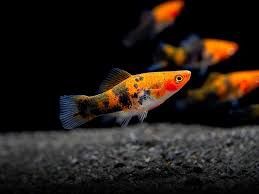Tri-colour Swordtail
Tri-colour Swordtail Care Guide
Tank Setup
-
Tank Size: Minimum 75 liters (20 gallons) for a small group. Larger tanks are better as they are active swimmers.
-
Substrate: Fine gravel or sand.
-
Décor: Provide plants (live or artificial), open swimming spaces, and hiding spots. They especially enjoy heavily planted tanks with floating cover.
-
Lighting: Moderate to bright – enhances their vibrant tri-colour patterns.
Water Parameters
-
Temperature: 22–28°C (72–82°F)
-
pH: 7.0–8.2 (prefer slightly alkaline water)
-
Hardness: 12–30 dGH
-
Filtration: Strong filtration with gentle to moderate flow, as they come from streams and rivers.
Diet
-
Omnivores – feed them high-quality flake or pellet food.
-
Supplement with live or frozen foods like bloodworms, daphnia, and brine shrimp.
-
They also appreciate vegetable matter such as blanched spinach, cucumber, or spirulina-based foods.
Tank Mates
-
Peaceful community fish.
-
Good companions include mollies, platies, guppies, tetras, danios, corydoras, and peaceful barbs.
-
Avoid aggressive or fin-nipping species.
Behavior
-
Active and lively swimmers.
-
Males have the signature “sword” extension on their tail fin.
-
Best kept in groups with more females than males (1 male per 2–3 females) to reduce stress on females.
-
They can reach around 12–15 cm (5–6 inches).
Breeding
-
Livebearers – females give birth to free-swimming fry.
-
Provide dense plants or breeding boxes for fry survival, as adults may eat them.
-
Gestation lasts about 4–6 weeks, and each brood can contain 20–100 fry.
Interesting Fact
Swordtails are closely related to platies, and the two species can interbreed, creating colorful hybrids that are popular in the aquarium hobby.

